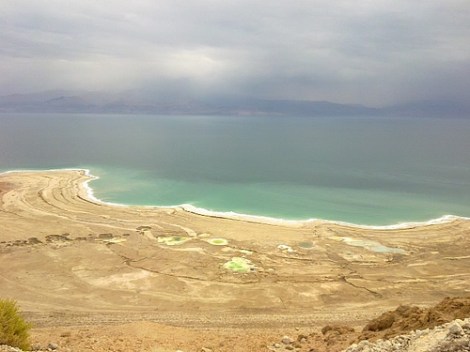The Dead Sea is dying, but there’s a bit of good news: We’re turning all of our oceans into the Dead Sea.
There are two qualities that set the Dead Sea apart — it’s warm and it’s salty. Happily, our oceans are picking up both of those traits. (Happily for those wishing to soak in warm, salty water. Unhappily for those who live in the water or near its shores or on Earth.)

barthelomausThe Dead Sea, now an ocean near you!
Getting warmer
From Maine’s Bangor Daily News:
Ed Monat, a seasonal tour boat operator and scallop fisherman from Bar Harbor, has seen a lot in his more than two decades of scuba diving below the waves of Frenchman Bay. …
One thing Monat never saw underwater prior to this past summer … was a 60-plus degree thermometer reading at the bottom of the bay. For much of the year, coastal waters in the Gulf of Maine generally are expected to waver between the mid-30s and mid-50s Fahrenheit, including at depths of 40-50 feet, where Monat often descends. On a late-August dive this summer near the breakwater that helps protect Bar Harbor from the open ocean, he said, his dive thermometer registered 63 degrees.
“That’s crazy, crazy warm,” Monat said recently. “This was a really warm summer in the water.”
This warmth isn’t only in the Gulf of Maine. It’s near Massachusetts and off the coast of Connecticut. It’s warmer in the Arctic and everywhere else. Thanks to our changing climate, oceans are warming and expanding.
And not just during the summer.
Patrice McCarron, executive director of Maine Lobstermen’s Association, said this month that rising temperatures in the gulf are “a huge concern” for the organization, the membership of which includes approximately 1,200 of the state’s 5,300 or so licensed commercial lobstermen. She said she has heard from some association members that water temperatures in the mouth of Penobscot Bay still, as of December, are unusually and consistently warm, from depths of a few feet to more than 150 feet.
“It’s 50 degrees throughout the water column,” McCarron said. “That’s crazy.”
Getting saltier
From Discovery:
The saltiness, or salinity, of the oceans is controlled by how much water is entering the oceans from rivers and rain versus how much is evaporating; what my kids recognize as “The Water Cycle.” The more sunshine and heat there is, the more water can evaporate, leaving the salts behind in higher concentrations in some places. Over time, those changes spread out as water moves, changing the salinity profiles of the oceans.
Oceanographers from Scripps Institution of Oceanography and Lawrence Livermore National Laboratory fingerprinted salinity changes from 1955 to 2004 from 60 degrees south latitude to 60 degrees north latitude and down to the depth of 700 meters in the Atlantic, Pacific and Indian oceans. …
Next the ocean data was compared to 11,000 years of ocean data generated by simulations from 20 of the latest global climate models. When they did that they found that the changes seen in the oceans matched those that would be expected from human forcing of the climate.
Grab your beach chair, an umbrella, and some SPF 240 and meet me at the shore. I’ve always wanted to float in the Dead Sea’s famous waters. Little did I know that doing so would become so easy.




